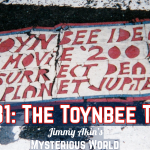
 Jimmy Akin's Mysterious World
Jimmy Akin's Mysterious World The Mystery of the Toynbee Tiles (2001, Resurrection, Jupiter)
Sep 27, 2024
Jimmy Akin, a renowned Catholic apologist and author, teams up with media producer Dom Bettinelli to delve into the intriguing mystery of the Toynbee Tiles. They discuss the bizarre messages etched in these tiles, linking them to cultural phenomena like Kubrick's '2001: A Space Odyssey.' The duo explores the creator's troubled psyche, theories of resurrection, and the philosophical implications of identity and existence. Their conversation reveals a labyrinth of paranoia, art, and unexpected connections to the cosmos that will leave listeners questioning the nature of reality.
Chapters
Transcript
Episode notes
1 2 3 4 5 6 7 8
Intro
00:00 • 3min
Unraveling the Toynbee Tiles Mystery
03:23 • 19min
Unraveling the Mystery of the Toynbee Tiles
21:58 • 2min
Unraveling the Toynbee Tiles Mystery
24:23 • 5min
Resurrection and the Cosmos
29:00 • 8min
Unraveling the Toynbee Tiles Mystery
36:31 • 24min
Exploring the Toynbee Tiles: Identity and Resurrection
01:00:47 • 23min
Exploring Resources and Upcoming Insights on Toynbee Tiles
01:23:26 • 4min


 Over the course of years and in dozens of cities across the world, strange tiles with bizarre messages began showing up affixed to streets. Jimmy Akin and Dom Bettinelli discuss the Toynbee Tiles, the bizarre ideas they convey, and who is behind them.
Over the course of years and in dozens of cities across the world, strange tiles with bizarre messages began showing up affixed to streets. Jimmy Akin and Dom Bettinelli discuss the Toynbee Tiles, the bizarre ideas they convey, and who is behind them.